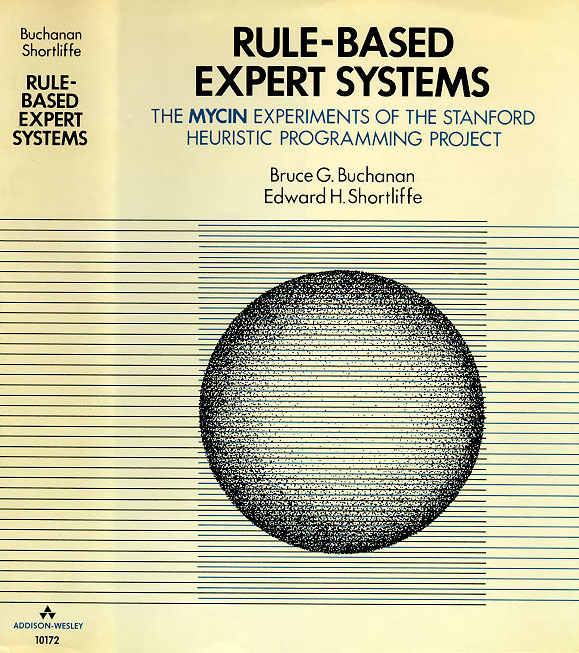
Rule-Based Expert Systems:
The MYCIN Experiments of the Stanford Heuristic Programming Project
Edited by Bruce G. Buchanan and Edward H. Shortliffe
754 pp., references, index, illus. electronic text
Addison Wesley, Reading, MA, 1984
Out of print. All chapters are freely available below.
Artificial intelligence, or AI, is largely an experimental science—at least as much progress has been made by building and analyzing programs as by examining theoretical questions. MYCIN is one of several well-known programs that embody some intelligence and provide data on the extent to which intelligent behavior can be programmed. As with other AI programs, its development was slow and not always in a forward direction. But we feel we learned some useful lessons in the course of nearly a decade of work on MYCIN and related programs. In this book we share the results of many experiments performed in that time, and we try to paint a coherent picture of the work. The book is intended to be a critical analysis of several pieces of related research, performed by a large number of scientists. We believe that the whole field of AI will benefit from such attempts to take a detailed retrospective look at experiments, for in this way the scientific foundations of the field will gradually be defined. It is for all these reasons that we have prepared this analysis of the MYCIN experiments.
Contributors
Foreword
Allen Newell
Preface
Part One: Background
Chapter 1—The Context of the MYCIN Experiments
Chapter 2—The Origin of Rule-Based Systems in AI
Randall Davis and Jonathan J. King
Part Two: Using Rules
Chapter 3—The Evolution of MYCIN’s Rule Form
Chapter 4—The Structure of the MYCIN System
William van Melle
Chapter 5—Details of the Consultation System
Edward H. Shortliffe
Chapter 6—Details of the Revised Therapy Algorithm
William J. Clancey
Part Three: Building a Knowledge Base
Chapter 7—Knowledge Engineering
Chapter 8—Completeness and Consistency in a Rule-Based System
Motoi Suwa, A. Carlisle Scott, and Edward H. Shortliffe
Chapter 9—Interactive Transfer of Expertise
Randall Davis
Part Four: Reasoning Under Uncertainty
Chapter 10—Uncertainty and Evidential Support
Chapter 11—A Model of Inexact Reasoning in Medicine
Edward H. Shortliffe and Bruce G. Buchanan
Chapter 12—Probabilistic Reasoning and Certainty Factors
J. Barclay Adams
Chapter 13—The Dempster-Shafer Theory of Evidence
Jean Gordon and Edward H. Shortliffe
Part Five: Generalizing MYCIN
Chapter 14—Use of the MYCIN Inference Engine
Chapter 15—EMYCIN: A Knowledge Engineer’s Tool for Constructing Rule-Based Expert Systems
William van Melle, Edward H. Shortliffe, and Bruce G. Buchanan
Chapter 16—Experience Using EMYCIN
James S. Bennett and Robert S. Engelmore
Part Six: Explaining the Reasoning
Chapter 17—Explanation as a Topic of AI Research
Chapter 18—Methods for Generating Explanations
A. Carlisle Scott, William J. Clancey, Randall Davis, and Edward H. Shortliffe
Chapter 19—Specialized Explanations for Dosage Selection
Sharon Wraith Bennett and A. Carlisle Scott
Chapter 20—Customized Explanations Using Causal Knowledge
Jerold W. Wallis and Edward H. Shortliffe
Part Seven: Using Other Representations
Chapter 21—Other Representation Frameworks
Chapter 22—Extensions to the Rule-Based Formalism for a Monitoring Task
Lawrence M. Fagan, John C. Kunz, Edward A. Feigenbaum, and John J. Osborn
Chapter 23—A Representation Scheme Using Both Frames and Rules
Janice S. Aikins
Chapter 24—Another Look at Frames
David E. Smith and Jan E. Clayton
Part Eight: Tutoring
Chapter 25—Intelligent Computer-Aided Instruction
Chapter 26—Use of MYCIN’s Rules for Tutoring
William J. Clancey
Part Nine: Augmenting the Rules
Chapter 27—Additional Knowledge Structures
Chapter 28—Meta-Level Knowledge
Randall Davis and Bruce G. Buchanan
Chapter 29—Extensions to Rules for Explanation and Tutoring
William J. Clancey
Part Ten: Evaluating Performance
Chapter 30—The Problem of Evaluation
Chapter 31—An Evaluation of MYCIN’s Advice
Victor L. Yu, Lawrence M. Fagan, Sharon Wraith Bennett, William J . Clancey, A. Carlisle Scott, John F. Hannigan, Robert L. Blum, Bruce G. Buchanan, and Stanley N. Cohen
Part Eleven: Designing for Human Use
Chapter 32—Human Engineering of Medical Expert Systems
Chapter 33—Strategies for Understanding Structured English
Alain Bonnet
Chapter 34—An Analysis of Physicians’ Attitudes
Randy L. Teach and Edward H. Shortliffe
Chapter 35—An Expert System for Oncology Protocol Management
Edward H. Shortliffe, A. Carlisle Scott, Miriam B. Bischoff, A. Bruce Campbell, William van MeUe, and Charlotte D. Jacobs
Part Twelve: Conclusions
Chapter 36—Major Lessons from This Work
Epilog
Appendix
References
Name Index
Subject Index
|
No comments:
Post a Comment
Note: Only a member of this blog may post a comment.